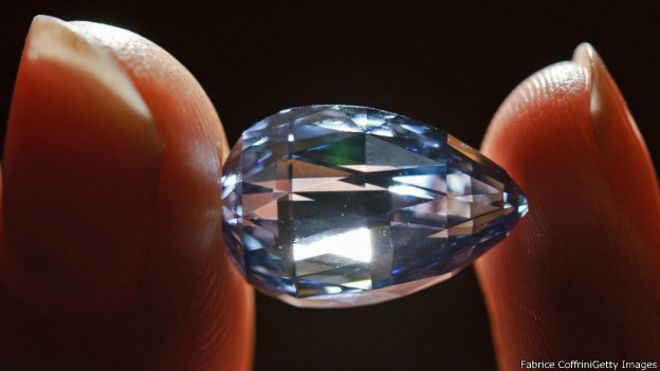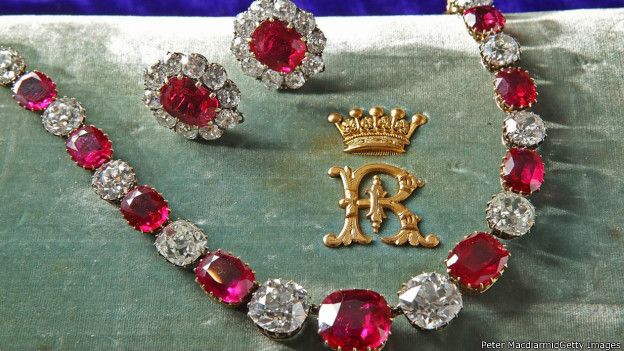如何选购钻石?
BBC阿丽娜·迪兹克(2023年12月3日)

切工,色泽,透明度和克拉重量是挑选钻石时的“4C标准”。
当32岁的鲍里斯·甘瑟维奇(Boris Gansevich)决定向他的女朋友求婚时,他驾车到附近的一家珠宝店来购买钻戒。但是,跟珠宝商三个小时的聊天之后,他还是两手空空地离开了。
“买钻戒可比买车复杂多了”,来自美国加利福尼亚州圣迭戈的IT项目经理甘瑟维奇回忆道。
最终,他花了四个多月的时间才买到。他在好市多(Costco)选中了一枚价值7500美元的镶有1.5克拉钻石的戒指,而好市多是以大量销售折扣商品而闻名的仓储量贩店,当然它也出售珠宝,电子产品,衣服和家具。
“一枚周围镶着一圈钻石的白金戒指”,他用他在研究过程中学到的术语解释道。“看上去棒极了。”他的未婚妻很喜欢。
爱情或金钱
选购这些珍贵的小石块需要投入很多顾客不曾预想的研究和跑腿工作。推动这些令人羡慕的珠宝的市场并不仅仅是浪漫而已。
莫斯科贝恩咨询公司(Bain & Company)的合伙人奥莱·林德(Olya Linde)表示,近期,一些对动荡的股票市场和无人问津的不动产投资出现动摇的顾客开始将他们的目光转向钻石。“这是能让投资者守住他们的资金的一种选择”,她说道。
领导完成了贝恩咨询2013年全球钻石市场研究报告(Bain’s 2013 Global Diamond Report)的林德表示,除了欧洲,北美甚至日本这些有购买钻石的传统的地区以外,印度和中国,这两个以有购买黄金和翡翠传统而闻名的国家,也开始逐渐成为全球740亿美元钻石市场的重要组成部分。
包括苏富比(Sotheby's)和佳士得(Christie's)在内的拍卖行也都见证了钻石销量的持续走俏。十月份,苏富比的一颗紫粉色钻石拍出了1777万美元的价格,平均每克拉211万美元,成为了单克拉价格最高的钻石。国际上钻石价格通常以美元计算。

重达59.6克拉的粉红之星(Pink Star)在2013年卖出了史上最高价8320万美元。
依据是什么
在购买这些昂贵的小玩意之前,不要只相信你的眼睛,要查看能够确认它的真实性和价值的4C相关文件:切口,色泽,透明度和克拉重量。切口看的是钻石的形状和比例,透明度来检测瑕点,克拉重量看尺寸,而色泽则关注颜色的深浅。色泽方面通过D到Z的等级(D级最好)来评估,而透明度则是从透明无瑕到13级。
钻石通常以4C标准进行分级以使得顾客能够确定他们有没有花冤枉钱——但是甚至钻石的产地也会增加它的价值。在选购传统钻石时,顾客应当选择那些反射光很强且没有明显瑕疵的浅色钻石,来自洛杉矶的雷纳·纽曼(Renee Newman)说道,他是《钻石评估实用指导》的作者。
还可以通过由诸如美国宝石学院和欧洲宝石学协会的第三方机构所签发的证书来比较钻石的价值。这些文件经常被视作有信誉的珠宝商生意的一部分,并且被承保人拿来作为确定钻石保险项目和替代价值的依据。
金伯利进程(The Kimberly Process)证书是常见的另一种证书,该证书由这家成立于2003年的钻石认证机构提供,帮助买家获取无冲突钻石,但是仍然有很多批评说它在减少冲突钻石的交易方面做得还不够。
人工钻石则要便宜的多,所以在购买之前一定要了解钻石是否是天然的,纽曼提醒道。

重达100.09克拉的格拉芙鲜彩黄钻(the Graff Vivid Yellow),它的大小是世所罕见的黄钻之一。
固定方式
选择珠宝时,要选那些固定安全的,以防钻石松动。“钻石一定要固定牢靠”,她说。
六爪镶的固定方式要比传统的四爪更安全,纽曼说。用一圈金属带紧紧包围住钻石的斜面固定方式基本上是最安全的。
同样地,也没有必要为了炫耀而购买过高等级的钻石。对于一般顾客,没有必要追求最好的透明度和色泽,来自位于加利福尼亚卡尔斯巴德(Carlsbad)市的美国宝石学院的高级分析师拉塞尔 绍尔(Russel Shor)说道。
固定方式也可以起到掩盖瑕疵的作用。“如果是镶嵌在戒指上,你会毫无察觉的”,绍尔说道,他同时也补充道,细微的瑕疵,也叫作内含物,一旦在钻石被固定之后肉眼几乎难以分辨。
不谈外表,一些切割很好的评级在G到J等级的含瑕疵的钻石可能比更高品质的那些要便宜几千美元。此外,选购重量小于一克拉的钻石可以省很多钱,因为钻石的价格是随着克拉重量的增加而大幅递增的。

这些黄钻曾是19世纪巴黎名妓拉·普艾娃(La Paiva)的饰物。
如何购买
镶嵌固定钻石的金属种类也可能使价格超出你的承受范围,但是也会有更实惠的选择。
珠宝设计师安娜·谢菲尔德(Anna Sheffield)通过在她为客户设计的优质珠宝上使用相对便宜的合金来冲抵购买钻石的费用。她设计的一款由纯银和小粒的铺排钻石所组成的手镯花费了1200美元——这要比固定在黄金上的类似产品便宜2650美元。
圆形的钻石也会比同样重量的公主方切口看上去更大。
“更贵的自然令人梦寐以求,”在纽约工作的谢菲尔德说。
另外,顶级的珠宝商品牌比如宝格丽(Bulgari),蒂芙尼(Tiffany),卡地亚(Cartier)以及其他一些稍小但却很受欢迎的珠宝商,它们的钻石首饰可能比钻石本身更加贵重。在过去十年中,顾客更加看重设计者的名气,这使得珠宝价格呈指数增长。
“可能一夜之间某个设计师的作品就被抢购一空”,纽曼说道。“但这并不一定——全看运气。”

像这颗19世纪的稀有钻石和红宝石这样的杰作,都是传世珍宝。
在线商城
虽然有的顾客对于在网上选购钻石非常谨慎,但一些在线专营店会提供同等品质下更便宜的价格。
位于美国西雅图的Bluenile网站(Bluenile.com)为顾客提供超过20万颗钻石的搜索服务,并可以进行质量和价格比较。网站商品销往50个国家,同样也包含向顾客介绍有关钻石交易的信息。所购商品都有30天退货政策。
在诸如Bluenile这样可靠的网站上进行购物的另一项好处就是拥有比传统柜台更大的选择范围,首席财务官大卫·宾得(David Binder)说。但是首先你得要做好功课。
投资钻石
如果你想要投资的话,绍尔建议购买那些容易转卖的裸石并且要“顶级”的,比如色泽等级在D到G的范围。
作为稀有钻石,彩色钻石在过去的五年其价值以指数增加,例如蓝色,紫色,黄色——以及令人垂涎的黑色——,开采10,000颗钻石之中才有一颗彩色钻石。有史以来售价最高的是一颗重达59.6克拉的叫做粉红之星的钻石,它是从非洲发现的一块132克拉重的水晶中切割出来的。在2013年的苏富比拍卖会上以8,320万美元的价格成交,但是在买家违约之后它又回到了拍卖行,估价7,200万美元。
“这些钻石不是拿来戴的——你会把它藏在最安全的箱底,”绍尔说。稀有钻石每克拉的均价可能达到10万美元。
大银行的财富经理可以帮忙购买投资用钻石,但是顶级的投资者往往借助佳士得和苏富比这样的拍卖行。世界钻石交易中心包括安特卫普,纽约,香港和特拉维夫,这些地方同样是寻找投资品质的钻石的好去处,林德说。
位于洛杉矶的钻石投资交易所是新近成立的几家钻石交易所之一,它为世界各地的顾客提供钻石配送服务,并允许买家以市场价将钻石卖回。
根据贝恩公司的研究,原钻价格自2008年金融危机以来增加了13%以上,目前正处在最高峰。买家愿意为钻石而一掷千金是因为他们对这些小石块寄予深情。“对消费者来说,它是一款让人为之心动的产品。”
选购钻石须知
鉴定:来自美国宝石学院,美国宝石协会和欧洲宝石学协会的鉴定书会确保钻石的质量,并验证它的切口,透明度,色泽和克拉重量。
了解退货政策:并非所有的好心珠宝商都会接受退货,因为钻石有可能会被石头或者廉价品替换。
投资价值:D级到F级的白钻,其中D级最好,以及较大的彩钻都是比较保险的投资选择。
寻求保险:很多家庭或租赁保险政策都含有付费的钻石珠宝附加条款。也有类似珠宝互助保险公司这样专做钻石保险业务的公司。
(责编:友义)
Romancing the stone: How to buy diamonds
By Alina Dizik,3 December 2024
When Boris Gansevich, 32, decided to propose to his girlfriend, he drove to a nearby jewellery store to buy a diamond ring. But, after a three-hour chat with the jeweller, he left empty handed. The process was more involved than he'd bargained for.
“It’s more complicated than buying a car,” remembered Gansevich, an IT project manager in San Diego, California, in the US.
In the end, it took him more than four months to make the purchase. He settled on a $7500 ring with a 1.5-carat diamond from Costco, a warehouse retailer mostly known for selling discounted food items in bulk, but which also offers a selection of jewellery, electronics, clothing and furniture.
A 0% APR (annual percentage rate) credit card helped Gansevich pay off the ring in monthly installments and a generous return policy meant he could bring back the ring within a year for a full refund.
“It’s a platinum setting with a halo of diamonds around it,” he said, using terminology he’d learned in his research. “It looked really good.” His fiancee loves it.
Love or money
Purchasing precious stones requires more research and legwork than many consumers realise. It’s not just romance that is driving the market for these covetable jewels.
These days, some consumers who are hesitant to invest in a volatile stock market and are priced out of real-estate investments are turning to diamonds, according to Olya Linde, a partner at consultancy Bain & Company in Moscow. “It’s an alternative investment that allows investors to hold on to their money,” she said.
While Europe, North America and even Japan have a culture of purchasing diamonds, India and China, traditionally known for purchasing more gold and jade, respectively, are becoming major players in the $74b global diamond market, according to Linde, who was the study lead on Bain’s 2013 Global Diamond Report.
Auction houses including Sotheby's and Christie’s have also seen a continuous uptick in diamond sales. In October, Sothebys sold a purple-pink coloured diamond at auction for $17.77m, the highest amount paid per diamond carat at $2.11m per carat. Diamonds are always benchmarked in US dollars globally.
What to look for
Before buying expensive baubles, don’t trust your eye and ask for the relevant documents showing proof the four Cs that verify a diamond’s authenticity and value: cut, colour, clarity and carat weight. The cut looks at the stone’s shape and proportions, the clarity examines imperfections, carat weight looks at size, while colour mostly tracks the absence of colour. Stones are assessed on a grading scale D through Z for colour (with D being best) and from flawless to 13 for clarity.
Diamonds are typically graded on these four Cs to help determine whether consumers are paying a fair price — but even the origin of the stone can add to its value. When purchasing traditional diamonds, buyers should look for colourless stones that reflect plenty of light without any visible imperfections, said Los Angeles-based Renee Newman, author of the Diamond Handbook: A Practical Guide of Diamond Evaluation.
Compare diamonds through certificates issued by like third-party labs such as the Gemological Institute of America and the European Gemological Laboratory. These documents are often part of the sale at reputable jewellers and used by insurers when determining coverage and replacement value.
The Kimberly Process, another certification offered with some diamonds, was established in 2003 to help buyers procure conflict-free diamonds, but still has many critics who say it’s not doing enough to discourage the sale of conflict diamonds.
Diamonds that have been artificially enhanced are significantly cheaper, so it’s important to understand whether the diamond is natural before making the purchase, Newman said.
Settings matter
When choosing your jewellery, look for settings that are secure and will keep the diamond from coming loose. “The diamond has to be set well,” she said.
Settings are safer with six prongs rather than the traditional four, said Newman. A bezel setting, which has a band of metal that wraps all the way around the diamond, can often be the most secure setting for a diamond.
As well, it isn’t always necessary to splurge on higher-grade diamonds. For the average consumer, there’s no need to purchase the best quality in terms of clarity and colour, said Russel Shor, a senior analyst with the GIA in Carlsbad, California.
Settings can be made to cover imperfections. “If it’s mounted on a ring, you won’t notice anything,” said Shor, who adds that minor flaws, called inclusions, can often be invisible to the naked eye once the diamond is set.
Diamonds rated G through J with some inclusions that are cut well, can be thousands of dollars cheaper than a higher quality stone, without compromising the look. Additionally, purchasing a diamond smaller than one carat can be significantly less expensive as prices rise steeply at every whole carat weight.
How to buy it
Expensive settings can push the price of your diamond jewellery out of reach, but there are more affordable alternatives.
Jewellery designer Anna Sheffield offsets the expense of purchasing a diamond, by using less-expensive mixed metals in some of the fine jewellery she designs for her customers. A version of her Pave Wheat bracelet incorporating sterling silver and smaller pave-style diamonds costs $1200 — that’s $2650 less than a similar version set in gold.
A round diamond shape can also appear bigger than the square princess cut with a similar carat weight.
“It’s aspirational to the more expensive versions,” said Sheffied, who is based in New York.
Additionally, diamond jewellery by top brands such as Bulgari, Tiffany, Cartier, along with smaller sought-after jewellers, can be worth more than the diamond alone. In the last decade, consumers have placed a higher value on designer names, which can increase the price of the jewel exponentially.
“All of a sudden a designer’s piece can be in high demand,” said Newman. “But it’s not guaranteed — it’s a matter of luck.”
The online market
While many customers are wary of purchasing diamonds online, some web-only retailers can offer cheaper prices for quality stones.
Bluenile.com, based in Seattle, in the US, allows customers to search through more than 200,000 diamonds in its inventory and compare the quality and price of particular stones. The website, which sells to 50 countries, also contains information to help educate consumers about the diamond trade. Purchases come with a 30-day return policy.
Another benefit of buying online from reputable companies such as Bluenile is the larger selection offered over a traditional jewellery store, said Chief Financial Officer David Binder. But do your homework.
Diamonds as an investment
If you are looking for an investment, Shor recommends purchasing loose stones that are easily resalable and “top of the line” such as those in the D through G categories on the colour scale.
Known as rare diamonds, coloured diamonds in blue, pink, yellow — and the coveted black — have increased in value exponentially in the last five years and are only one of every 10,000 diamonds mined, he said. The most expensive diamond ever sold is a 59.6 carat pink diamond called the Pink Star, which was cut out of a 132-carat crystal found in Africa. It was sold at Sotheby's for $83.2m in 2013, but has been reacquired by the auction house and valued at $72m after the buyer defaulted.
“These diamonds are not meant to be worn — you put them in the bottom of the safe,” Shor said. Rare diamonds can cost on average of $100,000 per carat.
Wealth managers at major banks can help facilitate the purchase of an investment diamond, while top investors often turn to auctions at Christie's and Sotheby's. Dealers in the world’s diamond hubs including Antwerp, New York, Hong Kong and Tel Aviv can also be a good place to turn for finding investment-quality stones, Linde said.
The Investment Diamond Exchange, one of several startup diamond exchanges based in Los Angeles now ships diamonds to buyers all over the world and allows buyers to sell back the diamonds at market prices.
Rough diamond prices have risen 13% or more since the 2008 financial crisis and are now at their peak, according to Bain. Buyers are willing to spend on stones because they are sentimental about the item. “For the consumer, it’s a very emotional product.”
Making a Diamond Purchase
What you need to know
Get certified: Certificates from the Gemological Institute of America, American Gem Society and European Gemological Laboratory ensure quality and verify cut, clarity, colour and carat weight.
Check the return policy: Not all fine jewellers accept returns because of the potential for diamonds to be replaced with stones of lesser value.
Investment quality: White diamonds graded D through F, with D being best, and larger coloured diamonds can be a safe investment alternative.
Find insurance: Many home or renters’ insurance policies sell extensions to cover diamond jewellery. Some companies such as Jewelers Mutual Insurance Co specialise in jewellery insurance.